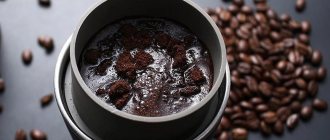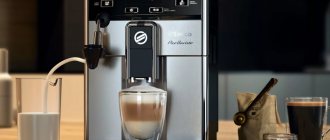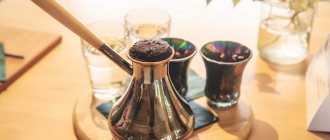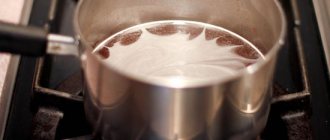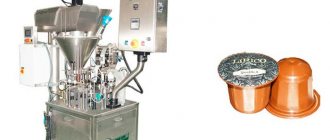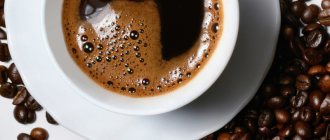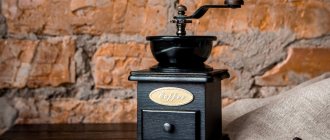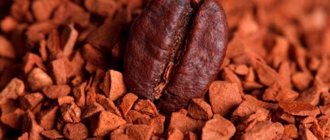Grind Selection
Well-prepared filter coffee has no grounds or suspended particles, so you can drink it to the bottom. To achieve purity of the drink, you need to use the correct grind.
Coarsely ground coffee is better for drip coffee makers than finely ground coffee. You need to look for the corresponding inscription or picture on the pack. The device prepares a full bowl in 6-8 minutes. During this time, large particles have time to heat up sufficiently and brew. The coffee turns out rich, moderately strong, without suspension or excess bitterness. Ideal particle size, like fine crystalline sugar. Lovers of a strong drink can choose a slightly finer grind.
The larger the particles, the lighter the taste. The coarsest grind (like for a French press or Chemex) is not suitable: it will brew weakly.
A pronounced smell of burnt beans and an unpleasant bitter taste appear if the coffee powder is overheated. This happens if fine or even fine grinding is used. Water hardly passes through the thickness of the coffee powder, washing out as much as possible from it. Cooking time increases. The drink turns out cloudy, with suspension. In addition, it contains higher caffeine content.
- This is interesting: Is caffeine a drug?
Drip coffee makers use disposable paper filters or reusable mesh filters. Coarser filters (metal or nylon) only retain large grains. Paper filters can also catch small particles, but finely ground coffee will still turn out bitter.
Modern equipment from the middle and high price categories may have an additional option - grinding the grains immediately before cooking. Such units provide the required fraction, so you don’t have to look for the “correct” ground coffee for a drip coffee maker, but buy grain and entrust its grinding to the equipment.
How does a drip coffee maker work?
A filter coffee maker (this is its second name, which fully reflects the principle of operation) is a fairly simple device. Technically, it consists of a water tank, a heater, a filter into which the coffee is placed, and a glass coffee pot where the finished coffee goes.
Water from the water tank enters the heater, then a mixture of hot water and steam rises through a tube into the compartment with coffee, the steam condenses and in the form of drops (the temperature is 100 degrees) flows through the ground coffee into the coffee pot already in the form of a drink (the temperature drops to 87 –95 degrees). More sophisticated models have a timer so that the coffee is prepared at a specific time. Expensive models can be linked to an application on your phone to brew a drink remotely. But this does not change the principle of operation of the device.
Caring for the coffee maker is as simple as possible: you just need to wash the coffee pot and filter (or replace it with another one if you are using disposable ones).
Strait speed
Not all devices are able to regulate the speed of hot water supply to the filter with coffee powder. If there is such a function, you can try making coffee of different strengths and richness. Fast preparation means a less concentrated drink. If you are patient and set the pour speed to minimum, the coffee will brew better.
In a device without adjusting the flow rate, power matters: a “weaker” device will heat the water more slowly, therefore, the drink will be stronger. A power of 800 W is quite enough.
Most coffee makers use all the water placed in the top container.
In order not to get a too watery taste, you need to pour the volume that is needed, without reserve. For a rich drink, you need to maintain the correct ratio between water and coffee.
How to get a delicious drink?
- Power adjustment. The strength is affected not only by the amount of liquid and how much ground coffee you add, but also by the speed at which drops permeate through the beans. The faster the process, the less rich and strong the finished drink will be. By choosing the minimum power, you will brew coffee with a bright taste.
- Water. Use only high quality bottled water.
Note! You should pour the water slowly to saturate it with oxygen, then the finished drink will taste better.
- Choice of ground coffee. The most important point. You can’t skimp on good blends or single varieties. Grinding for a drip coffee maker, according to experts and reviews from coffee lovers, is recommended to be medium or coarse.
Drip coffee maker
Review of popular brands
Drip coffee makers are simple and easy to use: you don’t need special barista skills to operate them. The key to a tasty drink is high-quality raw materials. Most coffee brands have products in their range that are the best option for preparing this method. To choose coffee for a drip coffee maker, you first need to pay attention to the grind.
Drip coffee makers have increased coffee consumption compared to other preparation methods (60 grams per 1 liter of water, or 2 full teaspoons per 150 ml). Products suitable for them can often be found in large 500 gram packages.
Lavazza Filtro Italiano Delicato
Italians love the Lavazza brand and are proud of it. They have a reason for this: highly qualified specialists roast high-quality beans from all over the world and form unique blends.
This blend contains a rich, harmonious taste with honey and chocolate undertones. Despite the small addition of robusta, the drink turns out to be truly delicate, as its name promises.
Paulig Presidentti Original
Finns love coffee very much and drink liters of it. Almost every home has a drip coffee maker with a heating function: this is the best way to always have a cup of your favorite drink at hand. Arabica beans from Brazil and Central America, lightly roasted (Scandinavian style) and coarsely ground, have a balanced flavor with a slight berry acidity.
Illy Filter Coffee
Premium products are a blend of nine Arabica varieties with a rich flavor. There is a slight sourness, a slight noble bitterness, and a pleasant chocolate aftertaste. Many coffee lovers consider Illy coffee to be the best coffee for a drip coffee maker due to its precise grind size. Sold in tins.
Mövenpick Der Himmlische
The German-Swiss manufacturer produces a traditionally high-quality product. A mixture of beans from different continents has a rich, dense taste and pronounced aroma thanks to a medium roast suitable for drip coffee makers.
Dallmayr Prodomo
This German lightly roasted coffee is very mild: not bitter at all. It has a slight sourness, a sweet aftertaste and a rich aroma. The Arabica beans for this brand are grown in the highlands of Ethiopia.
- Don't miss: What is the difference between Arabica and Robusta
What does grind size affect?
To understand whether the size of the fractions of crushed coffee beans affects the taste, how the smell changes depending on this criterion, you need to understand the essence of the processes that occur during the preparation of the drink. During cooking, there is a transition of substances that give the characteristic taste and aroma from the grains into the liquid (extraction). The speed at which they move into the water varies. The acid transition is the fastest. Minerals and tannins are transferred slowly. In addition, aromatic fractions disintegrate when heated excessively.
If the extraction is short, the drink turns out to be weak and sour, and if the extraction is too long, it turns out bitter, without a characteristic aroma.
Through trial and error, the optimal time for interaction of coffee fractions with water was determined, depending on the preparation method. When using a French press this is 3-4 minutes, for a coffee machine - a maximum of 25 seconds. It is worth noting that these recommendations will be effective only if the degree of grain grinding is correctly selected.
It is impossible to say unequivocally which coffee grind is better. It has been noted that particle sizes that are too small when placed in a French coffee maker for just four minutes will give the drink an overly bitter taste. Coarsely ground coffee will turn into a cloudy, sour liquid within half a minute of being in the coffee machine.
The most popular coffee recipes
Espresso
To make espresso you will need ground coffee beans (9 g) and water (30 ml). The cooking process is performed in the following sequence:
- Ground coffee is poured into the filter.
- Water is poured into the container.
- The coffee machine turns on and further actions are performed automatically.
- When all the drink has collected in the coffee pot, it is poured into cups that need to be preheated.
Latte
Lightened coffee latte is made from several components. You will need ready-made espresso (50 ml), milk (200 ml), cinnamon (1 pinch), chopped nuts (3 g).
Preparation includes a certain procedure:
- Espresso coffee is prepared in a coffee maker and then poured into a high-sided glass.
- The milk is whipped with a mixer or blender.
- Frothed milk is poured over the espresso.
- Milk foam is placed on top.
- The surface of the foam is sprinkled with cinnamon and nuts.
Viennese cappuccino
The main ingredients for cappuccino will be pre-prepared espresso (50 ml), whipped cream (50 ml), milk (200 g), chocolate (20 g). The drink is created according to the following recipe:
- Heat the milk and pour it into a glass.
- The espresso is poured in slowly and carefully.
- Whipped cream is placed on top.
- Chocolate chips are scattered on the surface of the cream.
Irish coffee drink
This drink is very popular in Ireland. To create it you will need ready-made espresso (60 ml), sugar (20 g), cream (40 ml), whiskey (30 ml), water (20 ml).
How to choose?
When choosing a high-quality coffee maker, there are a huge number of aspects to consider. After all, in order for the coffee maker to serve for a long time and properly, all the parts in it must work like a clock. Let's try to figure out what you should pay attention to when buying a drip coffee maker:
Typically, the material of a coffee maker is considered specifically the area where the coffee itself is placed, specifically the coffee pot. In this area, the material is in contact with water the longest, which means that there is a high possibility of water stagnation and thinning of the material. Therefore, it is worth paying attention specifically to the glass coffee pot. More economical models offer plastic containers in their samples, but, as practice shows, they are short-lived. The only advantage of this material is that it will not break if dropped, but cheap plastic in particular has a very significant effect on the quality of the finished drink, because it has a nasty smell when heated. Therefore, when choosing a drip coffee maker, you must first sort out those devices whose coffee pot is not made of glass.
This is the 2nd most important parameter. Filters in this device can be of several types:
- Cardboard. This is the most recognizable and most common type. This filter has great advantages over other types, namely that the paper itself has good filtration properties; it retains inside itself the nasty sediment from ground coffee, containing harmful substances such as caffeol and caffestol. A drink that has passed through a disposable filter is much healthier than if it passed through a reusable filter, it is also much more convenient to use, there is no need to wash and clean it, the old one is immediately disposed of, and a new one is put in its place. There is no need to bother with the dirty cavity of the coffee maker at all. Moreover, if you don’t immediately wash off the dried stains, it will be much more difficult to do so later. Paper filters are very cheap, so when choosing a coffee maker, you don’t have to worry that constantly replacing them will significantly impact your budget.
- Iron. The indisputable advantage of the iron filter is, first of all, its repeated use. Some manufacturers still use this element in the manufacture of drip coffee makers. The peculiarity of this filter is that when water passes through the grains, not all substances are retained in it, as in the first type of filters. Coffee, therefore, acquires a certain specific taste. From time to time this brewing method is called “Indian”. Therefore, when choosing a coffee maker with an iron filter, you should first try the taste of the finished coffee, and only later make a final decision, because you may be disappointed. But it should be noted that such coffee makers do not exclude the possibility of using disposable filters. Of course, the biggest disadvantage of an iron filter is that it needs to be washed immediately, which is very problematic from time to time, especially if there is absolutely no time.
- Nylon. It can be considered a candidate for the iron filter, because their principle of operation is identical. The nylon filter appeared on the coffee maker market relatively recently, and its implementation is a personal matter, but like an iron filter, it needs repeated replacement, otherwise the finished drink will have a nasty taste and smell. On average, a nylon filter is designed for 60-80 uses. It is necessary to wash it, just like the iron filter, after each use.
- Gold filter. This is the same nylon filter, but coated with titanium. Manufacturers say that it lasts much longer than other types and requires replacement no earlier than after 150 uses. You will also have to wash it; in operation, it is no different from an ordinary nylon filter, and its price is an order of magnitude higher. Therefore, it is believed that the “golden” filter is less than an advertising ploy by manufacturers.
Despite the fact that the most important elements in a coffee maker have already been considered, it is worth focusing on such a detail as the volume of the test tube. It would be correct to first calculate the number of people who will drink coffee at once. For example, for a family of 2 people you should not buy a coffee maker designed to produce 1.5-2 liters in one cycle. coffee. It would also be stupid to take a small coffee maker designed to make 2 glasses of coffee for the whole office. In this case, it’s worth paying attention to larger coffee makers.
Depending on the largest volume of water, manufacturers choose the power of the coffee maker. Some are inclined to believe that the higher the power of the coffee maker, the stronger the drink. This is an incorrect statement. The strength of the drink depends on the number of grains poured into the filter. When choosing a coffee maker, it is again worth considering the number of people who will immediately drink coffee. The average power of an ordinary coffee maker is 1kW +/- 100W.
Very often, coffee maker manufacturers try to somehow stand out from their competitors by introducing various innovations into their inventions. This also applies to drip coffee makers. The latest models of such devices have functions such as “Turk” - the process of making coffee becomes so “natural” that the resulting drink is identical to coffee, as if “handmade” in a true Turk. Also, more advanced models are developed according to the “2 in 1” scheme: one platform contains a drip coffee maker with a cappuccino maker and a removable tank, which allows you to use it in various cases, depending on what drink you want to brew at a given moment.
Correct grinding is the key to properly prepared coffee
Ultrafine processing consists of bringing the raw material to a virtually powdery state. This type of grinding is suitable for making an oriental Turkish drink. It takes about 3 to 5 minutes to make until the foam starts to rise. Additionally, you can use spices.
Fine grind coffee is used to make espresso in special machines. If you put very small powder into the machine, the coffee will be bitter, and if you use coarse raw materials, the drink will turn out to be very liquid. Also, similar processing is suitable for making the product in carob coffee makers.
The average half-mole level is suitable for drip coffee machines. The powder is placed inside a special filter, onto which the hot water, passing through the ground grains, absorbs the smell and taste of the real drink.
Hard ground coffee is usually used to make the product in geyser-type coffee makers. Hot steam passes through the layer of prepared raw materials, which is collected in a container from above. Production time is about 5 minutes.
